| Listing 1 - 10 of 29 | << page >> |
Sort by
|
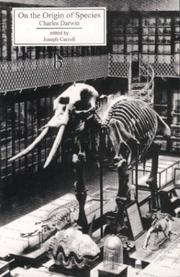
Abstract | Keywords | Export | Availability | Bookmark
 Loading...
Loading...Choose an application
- Reference Manager
- EndNote
- RefWorks (Direct export to RefWorks)
Book
ISBN: 1281758353 9786611758356 1935155946 9781935155942 Year: 2003 Publisher: Arlington, Va. NSTA Press
Abstract | Keywords | Export | Availability | Bookmark
 Loading...
Loading...Choose an application
- Reference Manager
- EndNote
- RefWorks (Direct export to RefWorks)
Strange intruders are invading our part of the world, threatening our environment and our economy. These newcomers and their impact on our ecological balance are the focus of Invasion Ecology , a new book that teaches students to investigate the behaviors of nonnative and native species. Studying real-life invaders such as purple loosestrife and Phragmites, students will learn about the links between biology and ecology -- and explore how scientists are fighting these aggressors with biological controls.
Biological invasions. --- Natural selection. --- Darwinism --- Selection, Natural --- Genetics --- Variation (Biology) --- Biological invasions --- Evolution (Biology) --- Heredity --- Bio-invasions --- Bioinvasions --- Invasions, Biological --- Natural selection --- Population biology
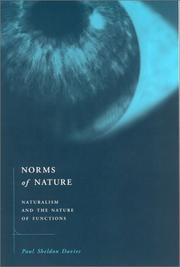
ISBN: 0262271257 0585481040 0262541440 0262041871 9780262271257 9780585481043 9780262041874 9780262541442 Year: 2003 Publisher: Cambridge, Mass. London MIT
Abstract | Keywords | Export | Availability | Bookmark
 Loading...
Loading...Choose an application
- Reference Manager
- EndNote
- RefWorks (Direct export to RefWorks)
The components of living systems strike us as functional-as for the sake of certain ends--and as endowed with specific norms of performance. The mammalian eye, for example, has the function of perceiving and processing light, and possession of this property tempts us to claim that token eyes are supposed to perceive and process light. That is, we tend to evaluate the performance of token eyes against the norm described in the attributed functional property. Hence the norms of nature.What, then, are the norms of nature? Whence do they arise? Out of what natural properties or relations are they constituted? In Norms of Nature, Paul Sheldon Davies argues against the prevailing view that natural norms are constituted out of some form of historical success--usually success in natural selection. He defends the view that functions are nothing more than effects that contribute to the exercise of some more general systemic capacity. Natural functions exist insofar as the components of natural systems contribute to the exercise of systemic capacities. This is so irrespective of the system's history. Even if the mammalian eye had never been selected for, it would have the function of perceiving and processing light, because those are the effects that contribute to the exercise of the visual system. The systemic approach to conceptualizing natural norms, claims Davies, is superior to the historical approach in several important ways. Especially significant is that it helps us understand how the attribution of functions within the life sciences coheres with the methods and ontology of the natural sciences generally.
Biology --- Health & Biological Sciences --- Biology - General --- Natural selection. --- Naturalism. --- Naturalism --- Natural selection --- Darwinism --- Selection, Natural --- Philosophy. --- PHILOSOPHY/Philosophy of Science & Technology --- Materialism --- Mechanism (Philosophy) --- Philosophy --- Positivism --- Science --- Genetics --- Variation (Biology) --- Biological invasions --- Evolution (Biology) --- Heredity --- Vitalism
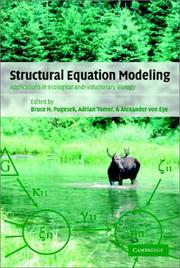
ISBN: 1107129168 1280417943 9786610417940 0511178778 1139146432 0511066880 0511060572 0511305958 0511542135 0511069014 9780511066887 9780511069017 9780511178771 9780521781336 0521781337 6610417946 0521781337 9781107129160 9781280417948 9781139146432 9780511060571 9780511305955 9780511542138 9780521104029 0521104025 Year: 2003 Publisher: Cambridge ; New York : Cambridge University Press,
Abstract | Keywords | Export | Availability | Bookmark
 Loading...
Loading...Choose an application
- Reference Manager
- EndNote
- RefWorks (Direct export to RefWorks)
Structural equation modelling (SEM) is a technique that is used to estimate, analyse and test models that specify relationships among variables. The ability to conduct such analyses is essential for many problems in ecology and evolutionary biology. This book begins by explaining the theory behind the statistical methodology, including chapters on conceptual issues, the implementation of an SEM study and the history of the development of SEM. The second section provides examples of analyses on biological data including multi-group models, means models, P-technique and time-series. The final section of the book deals with computer applications and contrasts three popular SEM software packages. Aimed specifically at biological researchers and graduate students, this book will serve as valuable resource for both learning and teaching the SEM methodology. Moreover, data sets and programs that are presented in the book can also be downloaded from a website to assist the learning process.
Ecology --- Evolution (Biology) --- Animal evolution --- Animals --- Biological evolution --- Darwinism --- Evolutionary biology --- Evolutionary science --- Origin of species --- Biology --- Evolution --- Biological fitness --- Homoplasy --- Natural selection --- Phylogeny --- Mathematical models. --- Statistical methods.
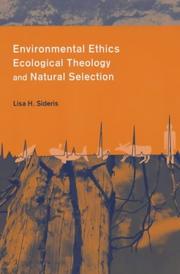
ISBN: 0231126611 023152949X 0231126603 9780231126618 Year: 2003 Publisher: New York (N.Y.): Columbia university press
Abstract | Keywords | Export | Availability | Bookmark
 Loading...
Loading...Choose an application
- Reference Manager
- EndNote
- RefWorks (Direct export to RefWorks)
In the last few decades, religious and secular thinkers have tackled the world's escalating environmental crisis by attempting to develop an ecological ethic that is both scientifically accurate and free of human-centered preconceptions. This groundbreaking study shows that many of these environmental ethicists continue to model their positions on romantic, pre-Darwinian concepts that disregard the predatory and cruelly competitive realities of the natural world. Examining the work of such influential thinkers as James Gustafson, Sallie McFague, Rosemary Radford Ruether, John Cobb, Peter Singer, and Holmes Rolston, Sideris proposes a more realistic ethic that combines evolutionary theory with theological insight, advocates a minimally interventionist stance toward nature, and values the processes over the products of the natural world.
241.65*7 --- Selection, Natural --- Theologische ethiek: natuur; ecologie --- 241.65*7 Theologische ethiek: natuur; ecologie --- -Theologische ethiek: natuur; ecologie --- -Darwinism --- Environmental ethics --- Human ecology --- Natural selection --- Darwinism --- Genetics --- Variation (Biology) --- Biological invasions --- Evolution (Biology) --- Heredity --- Environmental quality --- Ethics --- Ecotheology --- Religious aspects --- Moral and ethical aspects --- Environmental ethics. --- Natural selection. --- Religious aspects. --- Human ecology - Religious aspects.
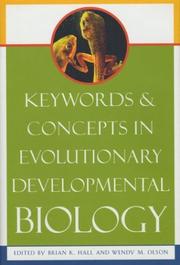
ISBN: 0674009045 Year: 2003 Publisher: Cambridge (Mass.) Harvard university press
Abstract | Keywords | Export | Availability | Bookmark
 Loading...
Loading...Choose an application
- Reference Manager
- EndNote
- RefWorks (Direct export to RefWorks)
Developmental biology. --- Evolution (Biology). --- Developmental biology --- Evolution (Biology) --- Animal evolution --- Animals --- Biological evolution --- Darwinism --- Evolutionary biology --- Evolutionary science --- Origin of species --- Biology --- Evolution --- Biological fitness --- Homoplasy --- Natural selection --- Phylogeny --- Development (Biology) --- Growth --- Ontogeny
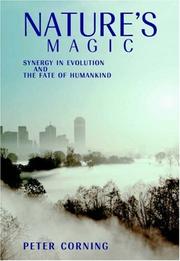
ISBN: 1107137683 0511078706 1280436794 9786610436798 051120633X 0511170432 0511297505 0511546424 0511077130 9780511078705 9780511077135 0511075596 9780511075599 9780511170430 0521825474 Year: 2003 Publisher: New York Cambridge University Press
Abstract | Keywords | Export | Availability | Bookmark
 Loading...
Loading...Choose an application
- Reference Manager
- EndNote
- RefWorks (Direct export to RefWorks)
Nature's Magic, first published in 2003, presents a bold vision of the evolutionary process from the Big Bang to the 21st century. Synergy of various kinds is not only a ubiquitous aspect of the natural world but it has also been a wellspring of creativity and the 'driver' of the broad evolutionary trend toward increased complexity, in nature and human societies alike. But in contrast with the many theories of emergence or complexity that rely on some underlying force or 'law', the 'Synergism Hypothesis', as Peter Corning calls it, is in essence an economic theory of biological complexity; it is fully consistent with mainstream evolutionary biology. Corning refers to it as Holistic Darwinism. Among the many important insights that are provided by this new paradigm, Corning presents a scenario in which the human species invented itself; synergistic, behavioral and technological innovations were the 'pacemakers' of our biological evolution. Synergy has also been the key to the evolution of complex modern societies, he concludes.
Evolution (Biology). --- Human evolution. --- Evolution (Biology) --- Human evolution --- Evolution --- Biology --- Health & Biological Sciences --- Physical anthropology --- Evolutionary psychology --- Human beings --- Animal evolution --- Animals --- Biological evolution --- Darwinism --- Evolutionary biology --- Evolutionary science --- Origin of species --- Biological fitness --- Homoplasy --- Natural selection --- Phylogeny --- Origin
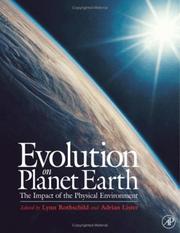
ISBN: 0125986556 9780080494852 0080494854 9786611012199 6611012192 128101219X 9780125986557 Year: 2003 Publisher: Amsterdam Boston Academic Press
Abstract | Keywords | Export | Availability | Bookmark
 Loading...
Loading...Choose an application
- Reference Manager
- EndNote
- RefWorks (Direct export to RefWorks)
Driving evolution forward, the Earth's physical environment has challenged the very survival of organisms and ecosystems throughout the ages. With a fresh new perspective, Evolution on Planet Earth shows how these physical realities and hurdles shaped the primary phases of life on the planet. The book's thorough coverage also includes chapters on more proximate factors and paleoenvironmental events that influenced the diversity of life. A team of notable ecologists, evolutionary biologists, and paleontologists join forces to describe drifting continents, extinction events, and climate
General palaeontology --- Evolution. Phylogeny --- Evolution (Biology) --- Evolution (Biologie) --- Animal evolution --- Animals --- Biological evolution --- Darwinism --- Evolutionary biology --- Evolutionary science --- Origin of species --- Biology --- Evolution --- Biological fitness --- Homoplasy --- Natural selection --- Phylogeny
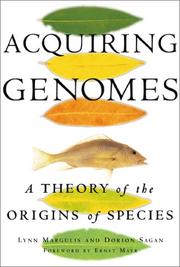
ISBN: 0465043917 9780465043910 0465043925 9780465043927 Year: 2003 Publisher: New York, NY Basic Books
Abstract | Keywords | Export | Availability | Bookmark
 Loading...
Loading...Choose an application
- Reference Manager
- EndNote
- RefWorks (Direct export to RefWorks)
In this groundbreaking book, Lynn Margulis and Dorion Sagan present an answer to one of the enduring mysteries of evolution — the source of inherited variation that gives rise to new species. Random genetic mutation, long believed to be the main source of variation, is only a marginal factor. As the authors demonstrate in this book, the more important source of speciation, by far, is the acquisition of new genomes by symbiotic merger. The result of thirty years of delving into a vast, mostly arcane literature, this is the first book to go beyond — and reveal the severe limitations of — the “Modern Synthesis” that has dominated evolutionary biology for almost three generations. Lynn Margulis, whom E. O. Wilson called “one of the most successful synthetic thinkers in modern biology,” and her co-author Dorion Sagan have written a comprehensive and scientifically supported presentation of a theory that directly challenges the assumptions we hold about the variety of the living world. (Provided by publisher)
Evolution (Biology). --- Species. --- Symbiogenesis. --- Species --- Symbiogenesis --- Evolution (Biology) --- Biological Evolution --- Genetic Variation --- Mutagenesis --- Selection, Genetic --- Symbiosis --- #SBIB:316.21H42 --- #SBIB:316.334.3M13 --- Theoretische sociologie: sociobiologie --- Medische sociologie: aanverwante disciplines --- Commensalism --- Mutualism --- Endosymbiosis --- Mycorrhizae --- Endophytes --- Genetic Selection --- Natural Selection --- Selection, Natural --- Genetic Fitness --- Mutageneses --- Mutation Accumulation --- Mutagens --- Mutation --- Teratogenesis --- Diversity, Genetic --- Genetic Diversity --- Variation, Genetic --- Diversities, Genetic --- Genetic Diversities --- Genetic Variations --- Variations, Genetic --- Biological Variation, Population --- Evolution, Biological --- Sociobiology --- Speciation (Biology) --- Biology --- Genetics --- Hybridization --- Organisms --- Animal evolution --- Animals --- Biological evolution --- Darwinism --- Evolutionary biology --- Evolutionary science --- Origin of species --- Evolution --- Biological fitness --- Homoplasy --- Natural selection --- Phylogeny
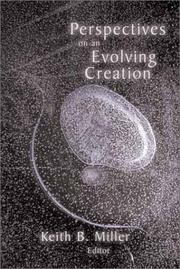
ISBN: 0802805124 Year: 2003 Publisher: Grand Rapids, Mich. Eerdmans
Abstract | Keywords | Export | Availability | Bookmark
 Loading...
Loading...Choose an application
- Reference Manager
- EndNote
- RefWorks (Direct export to RefWorks)
Cosmology --- Evolution. Phylogeny --- Christian dogmatics --- 215 --- Creationism --- Evolution (Biology) --- -Animal evolution --- Animals --- Biological evolution --- Darwinism --- Evolutionary biology --- Evolutionary science --- Origin of species --- Biology --- Evolution --- Biological fitness --- Homoplasy --- Natural selection --- Phylogeny --- Creation science --- Scientific creationism --- Modernist-fundamentalist controversy --- Bible and evolution --- Creation --- Intelligent design (Teleology) --- Godsdienst en wetenschap --- Religious aspects --- -Christianity --- Christianity --- Creationism. --- Christianity. --- -Godsdienst en wetenschap --- Animal evolution --- Religious aspects&delete& --- Anti-evolutionism --- Antievolutionism
| Listing 1 - 10 of 29 | << page >> |
Sort by
|

 Search
Search Feedback
Feedback About UniCat
About UniCat  Help
Help News
News